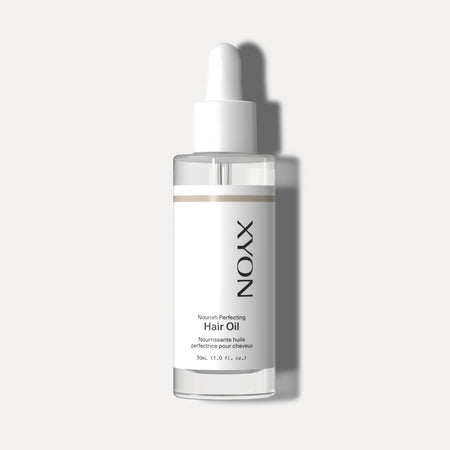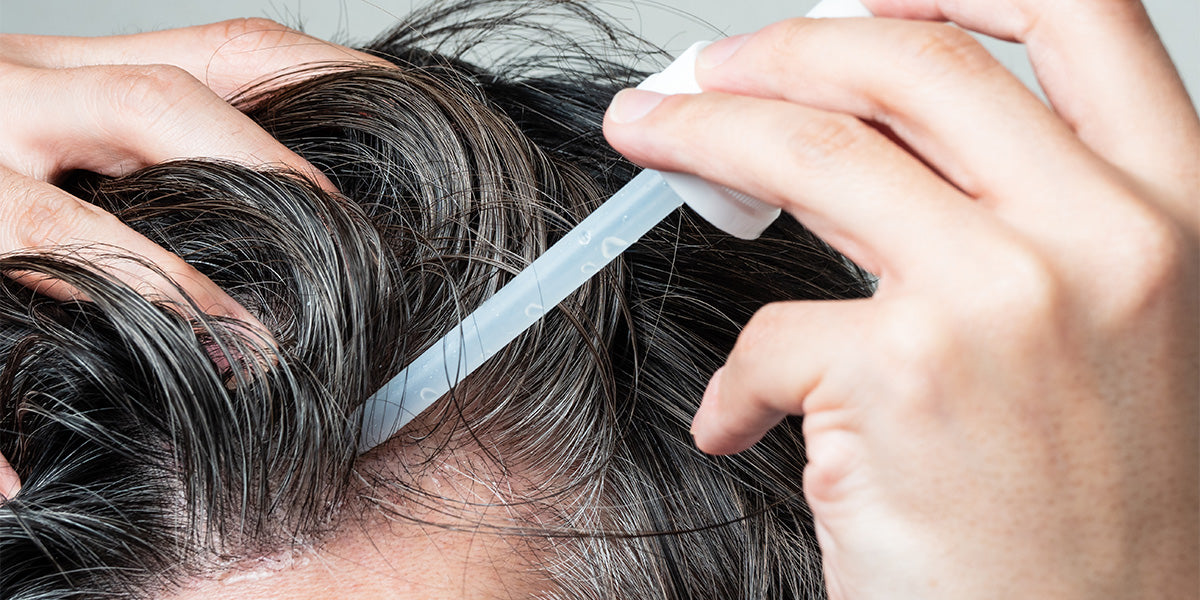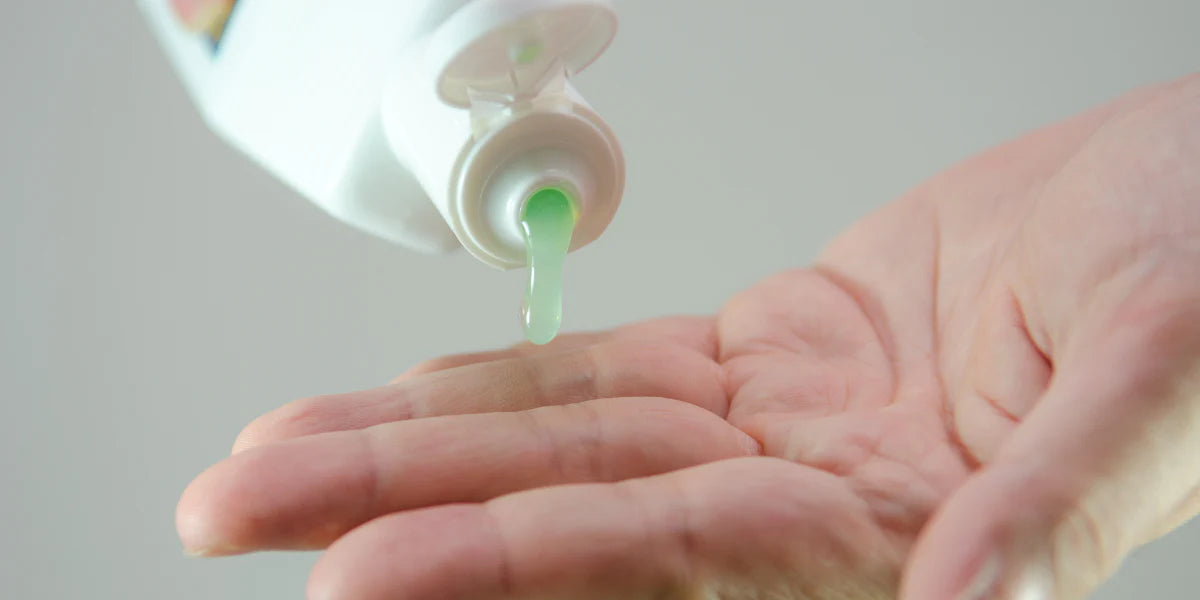When it comes to hair care, it can be both confusing and overwhelming trying to figure out which products are best suited to your hair. Amongst the countless different products available on the market, you’ve probably come across hair oils and serums but it’s not always clear how they’re different and what they actually do for your hair.
We think that both of these products can have a place in your hair care routine. To start, let’s break down what hair serum and hair oil are, how they’re different and explain which one might be most beneficial for you.


Xyon Nourishing, Perfecting Hair Oil
Our premium hair oil was designed by dermatologists to soften and smooth your hair while protecting it.
What is hair serum?
The distinction between hair oil and hair serum isn’t clear cut, but it partially comes down to differences in formulation and ingredients. In general, you’ll notice that serums are primarily water-based and made up of smaller molecules which can penetrate through the skin. When it comes to hair care, serums have a greater chance of impacting your hair on a functional level, as opposed to solely focusing on the outside appearance of your strands. The ability of serums to penetrate into the scalp makes it more likely for the ingredients to have prolonged contact with the hair follicles and work in the way they’re intended to.
Within the hair serum niche, there are countless different formulations which can further complicate your decision when it comes to buying. A popular type of formulation is something called a biphasic formulation and you might’ve come across this concept when exploring other cosmetic products, such as face washes and makeup removers. Biphasic hair serums allow for a greater range of different ingredients to be included within one product, helping to optimize what you get out of using a serum. So, let’s get into what exactly ‘biphasic formulation’ is and why you might choose a biphasic hair serum over another formula.
What is a biphasic formula?
Skin cells are made up of both aqueous and lipid components which means that solely water-based serums won’t interact with all structures within the scalp and result in poor absorption. But the water-based components play an important role, by hydrating the skin and creating pockets or channels for other ingredients to more easily enter the skin. Research has shown that a hydrated stratum corneum (outermost layer of the skin) can enhance skin permeability (Nakamura et al, 2023), meaning that important ingredients can penetrate the skin better. In this way, both water based and lipid (fat) based ingredients can reach their target skin structures.
Let’s also take a closer look at some of these key hair serum ingredients:
Our women’s serum includes two polypeptides (small proteins) called vascular endothelial growth factor (VEGF) and fibroblast growth factor (FGF). The serum also includes copper peptides, all of which have been shown to promote healthy hair growth.
- VEGF is believed to contribute to hair growth by promoting new blood vessel formation, which is understood to play a role in mediating the hair growth cycle (El-Refaey et al, 2018).
- FGF has been proven to promote hair growth by stimulating hair follicles to enter the active growth phase of the hair cycle sooner (Lin et al, 2015).
- Copper peptides are thought to be important compounds for hair growth, which work to accelerate the hair growth cycle through improving microcirculation, boosting cell production and stimulating crucial pathways involved in hair growth (Lui et al, 2024).
What is hair oil?
As you probably gathered from the name, hair oils are oil-based products, usually aimed at deeply moisturizing the strands of hair. They’re comprised of natural oils derived from plants and seeds, each with unique hair health benefits and can also contain synthetically produced oils or lipid-based molecules. Compared to hair serums, hair oils tend to be heavier products and they can feel like they add more weight to your hair. Because of this, and depending on their hair type, some people avoid applying hair oils directly to the scalp and this can mean that your scalp misses out on the benefits of some ingredients.
XYON’s lightweight hair oil is packed with nourishing oils and plant extracts intended to help smooth your hair and restore its natural shine. The addition of natural DHT-blocking ingredients, such as saw palmetto have also been included to help address the hormonal causes of pattern hair loss and promote healthy hair growth when applied to the scalp. Meanwhile, the inclusion of fatty-acid-rich oils, such as almond oil, offers nourishment and moisturization that help to protect the hair and scalp.
Hair oils might be right for you if you’re looking to add shine to your hair strands and improve the moisture retention. If your hair tends to be on the drier side, you might have high porosity hair which means that your hair cuticle has lots of gaps in it, so it struggles to retain any moisture. Hair oils can be useful for sealing the cuticle layer and locking moisture into your strands, helping to reduce the appearance of frizz and prevent your hair from breaking easily. Oils can also help improve hair elasticity and flexibility, further reducing the likelihood of breakage.
What's better, conditioner or serum?
It can be confusing when you read the labels on hair conditioner and hair serums because at first glance, they seem to do the same thing. Ultimately, they both have the potential to improve the look and feel of your hair, but it’s how they impact the strands on the inside which sets them apart.
Conditioner is intended to be applied mostly to the ends of your hair where it can re-nourish the strands after shampooing. It’s typically recommended that you avoid applying conditioner directly to your roots, because it can cause an excess of oils and product build-up at the scalp and make the hair feel ‘greasy’ and look limp. Serums on the other hand, can be focused on the roots where they have a direct impact on the functionality and health of the hair strands, without impacting hair texture or volume.
When it comes to which is better, it’s impossible to make a direct comparison as they have fundamentally different functions and you’ll likely find that your hair would benefit from using both.
Hair oil vs leave-in-conditioner
Leave-in conditioner is designed to be applied to your hair and left on to detangle and smooth strands without causing breakage (this is common when brushing hair or trying to remove tangles/knots). They’re formulated to intensely moisturize the hair without adding any real weight.
You might be thinking that this sounds very similar to hair oil, so what are the real differences?
It’s not black and white, but it generally comes down to how to use each product in varying hair types/textures and hair goals. Leave-in conditioner is typically used for the purpose of detangling and moisturizing your hair after the shower, so it’s applied to damp hair and usually won’t be needed again until your next hair wash. Whereas hair oil wouldn’t generally be considered a ‘detangler’ and is instead used during styling and to improve the appearance of your hair. It adds shine to your hair and can help those with thicker and coarser hair to ease frizz and achieve their desired hair texture. It can also be used on damp or dry hair, as many times as needed (depending on your preference) between hair washes.
Takeaway: Hair oil vs hair serum
There’s no right or wrong way to approach your hair care routine but understanding the purposes of different products can be a useful tool when it comes to achieving your hair goals. Hair serums can have more to offer when it comes to functionally improving your hair and can offer more long-term benefits, whilst oils might have more of an immediate impact on the look and feel. In some cases, you might find yourself reaching for both of these types of products. This all comes down to your specific hair texture, needs and goals.
References
El-Refay, A.M., Behiry, E.G., Mansour, A.I., Hamed, A.M., Abdel-aziz, A.A. (2018). Evaluation of serum levels of vascular endothelial growth factor (VEGF) in female patients with telogen effluvium. Benha Journal of Applied Sciences (BJAS), 3(1), 27-30.
Lin, W., Xiang, L.J., Shi, H.X., Zhang, J., Jiang, J., Cai, P., Lin, Z.L., Lin, B.B., Huang, Y., Zhang, H.L., Fu, X.B., Guo, D.J., Lin, X.K., Wang, X.J., Xiao, J. (2015). Fibroblast growth factors stimulate hair growth through B-Catenin and Shh expression in C57BL/6 mice. BioMed Research International. https://doi.org/10.1155%2F2015%2F730139
Lui, T., Lui, Y., Zhoa, X., Zhang, L., Wang, W., Bai, D., Wang, Z., Wang, M., Zhang, J. (2024). Thermodynamically stable ionic liquid microemulsions pioneer pathways for topical delivery and peptide application. Biotactive Materials, 32, 502-513. https://doi.org/10.1016%2Fj.bioactmat.2023.10.002
Nakamura, E., Iwase, H., Arima-Osonoi, H., Sakuragi, M. (2023). Effects of water content on stratum corneum penetration mechanism of W/O type microemulsions. RSC Advances, 13, 17742-17749. https://doi.org/10.1039/D3RA02546B




